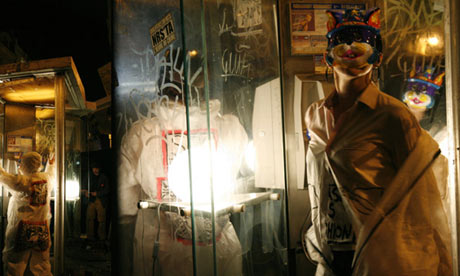
For intrepid art connoisseurs and those who just want to know a little more, our blog IVY Paris covers the underground art scene in the French capital. But here's the rub: in 2009 there is no real underground art scene in Paris.
As much as we Brits and Yanks would love to find some version of our own Hackney or Williamsburg, here there is little need for an underground. With its (champagne) socialist town hall, the city has always provided plenty of funding, space and publicity for the arts, so who needs to be a starving artist?
If you've traipsed through the contemporary galleries and experienced the numerous publicly endorsed events you will likely be left feeling a little underwhelmed. There isn't the competition (and with it perhaps the excitement) of London or New York. Even the famous art squats like Les-Frigos in the 13th arrondissement are now funded by the city. So much for sticking it to the man ...
IVY Paris suggests looking beyond the périphérique (the ring-road that encircles the city) into the great expanses known as "la banlieue". There's a thriving arts scene across the highway; on the edge by its very location.
There are institutions like MAC/VAL, which consistently produces some of the best in French contemporary art, dance and video. Located in Vitry-sur-Seine just south of Paris, MAC/VAL was the first contemporary art museum of the banlieue. It's just a short metro and bus ride from the city, but the emphasis is almost exclusively local. Surrounded by enormous gardens, its white walls and infinitely high ceilings make for an introspective and intimate space for introducing the latest emerging contemporary artists, as well as established names such as Gilles Barbier, Jesús Rafael Soto and Christian Boltanski.
Unlike the fly-by-night small underground gallery enterprises in London or New York, MAC/VAL is an established public entity in a modernised building, with constant upgrades and renovations. The museum enjoys yearly funding from the municipality of Val-de-Marne and has no problems supporting emerging French work.
In the infamous northern ('car burning") suburbs of St Denis and Aubervilliers, there are fantastic programmes and institutions. Les Laboratoires d'Aubervilliers is the type of place many artists would dream of; heavy on concept and opportunity, light on pomp and circumstance. Les Laboratoires asks artists to play with various mediums including performance, visual arts, sound and video - this past year, works from Les Laboratoires have been shown in one of central Paris's most prestigious venues for contemporary art, the Jeu de Paume.
Increasingly, these institutes that support emerging talent in the banlieues are seeing networking possibilities inside Paris proper, with heavyweight Palais de Tokyo being linked to all of the aforementioned groups, along with the canal-side Point Ephémère and the Main d'Oeuvres in Saint Ouen. All three spaces are targets for young fine art graduates looking to share a creative space within the city.
Further mainstream help comes from the robust and open-armed national association Maison des Artistes which provides artists with all types of benefits including subsidised studio space, tax breaks and free entry into many art institutions - and you would probably question any artist who decided to "work" underground here.
Just last year the city opened the much anticipated CentQuatre in the 19th, on the edges of the city ... and it has swiftly become a bridge between the centre and the banlieues. A massive building complex that spans nearly 35,000 square metres, it was created with the goal of developing a dialogue between the art world and the public - to erase the divide between the two - especially in the run-down area on the edge of town where it is located. The institution has launched a strong residency programme, promising a hearty stipend (€1,500 per month) for artists, who are encouraged to share their works-in-progress with the public. Bars and restaurants around the CentQuatre have seen a wave of new customers - most of them looking like they've wondered out of a Kooples catalogue, with their keffiyehs, distraught hair, dark rimmed glasses - who now mosey about the grounds as a daily hangout and meeting point.
Paris's attempt to build up the outer rings of the city is proof that the outlying suburbs are stirring people's attention, with CentQuatre being the focal point. Last year the building played host to Fiac's little sister Slick, an emerging art fair, which brought many well-heeled collectors to the 19th, probably for the first time in their lives.
The only tragedy in this whole rebirth is the inexcusable reluctance of the Parisian populace to wave the white flag and accept that, yes, Paris now actually extends far beyond the boundaries of the périphérique, and has done so now for quite some time.
Thankfully, there's a programme called Tram that hopes to facilitate those seeking a way to actually get out and see this stuff. Tram (or Le réseau art contemporain Paris/Ile-de-France), based in the 10th, offers transport and entry to and from the events and performances at 30 institutions throughout Ile-de-France. And on one Saturday each month, Tram also offers a more in-depth tour of an institution's new offerings. Prices for this service are €5 per person, or about 90% cheaper than a taxi ride.
So if you're ready to step off the insular island of Paris, take comfort in the fact that beyond the périphérique you'll find some of the most exciting work "the Capital" has to offer.

